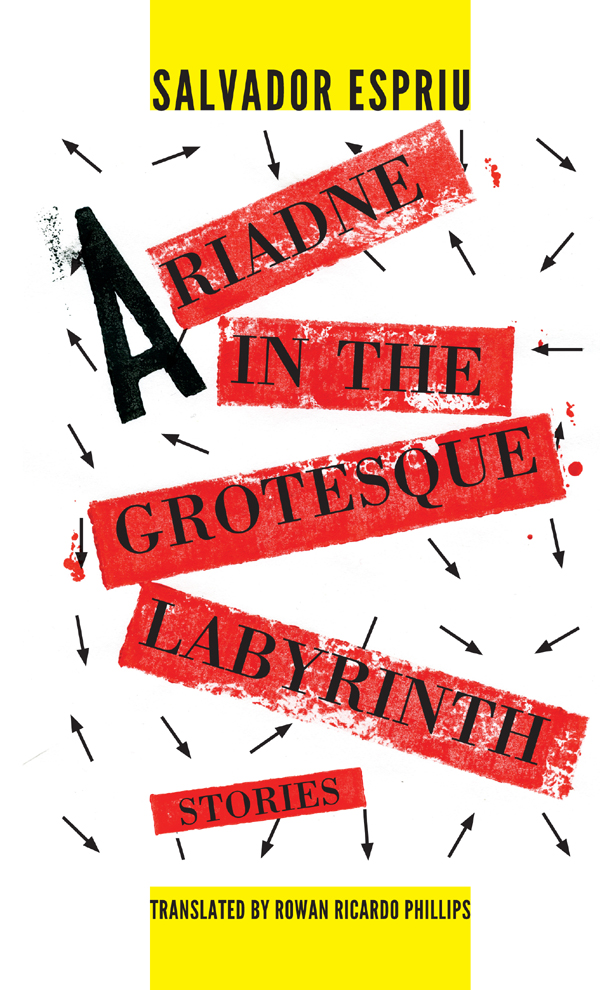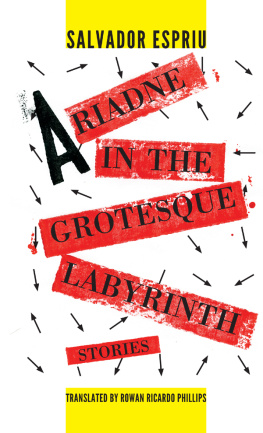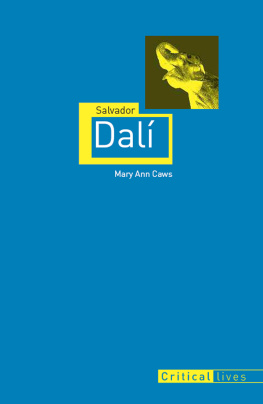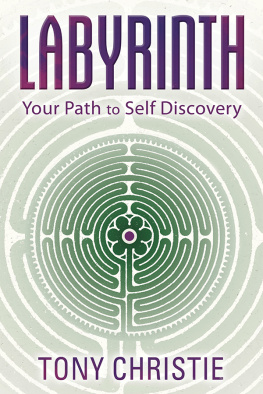
ARIADNE IN THE
GROTESQUE
LABYRINTH
SALVADOR ESPRIU
Translated by Rrowan Rricardo Phillips

Contents
Salvador Espriu continued to add storiessix more in allto the various editions of Ariadna al laberint grotesc that saw the light of day between the books first appearance in 1935 and the authors death in 1985, a period which spanned the rise, fall, and aftermath of Francos dictatorship. The last of these stories, the statement-of-purpose tinged The Young Man and the Old Man, was inserted by Espriu at the beginning of the book: the last becoming first. Both in form and function the prefatory The Young Man and the Old Man is a far more faithful introduction to the temperament of this masterpiece of Catalan literature than my prosaic intrusion into your enjoyment of it could ever be. An introduction to Ariadne in the Grotesque Labyrinth could occupy four times the pages of this slender text; and you, reader, will feel at times as though you could use one; but Espriu is interested in your beingor at least feelinglost, and in the threads that lead you toward feeling less so.
Ariadne in the Grotesque Labyrinth lifts the specious reality of the surfaces of Esprius world to reveal the awkward, kaleidoscopic reality that exists beneath it. Among modern writers, Espriu is the one who most abides by the inner logic of his own world-making. Hence, many of the lusciously-named characters who will appear in these stories (and subsequently re-appear, interrupting narratives seemingly at whim with a syncopated nonchalance) also appear in numerous other stories and poems within Esprius oeuvre. Similarly, the invented names of the locations in these stories will be unfamiliar to those new to Esprius work. They are as follows: Sinera, which is Arenys backwardsEspriu is from Arenys de Mar, a coastal town about an hour north of Barcelona; Lavnia for Barcelona; Alfaranja for Catalunya; and Konilsia for Spain. This last place-name plays on the Catalan word for rabbit, conill, and the name given to Spain by the arriving Carthaginians around 300 B.C.: Ispanialand of the rabbits.
What is a grotesque labyrinth? The adjective evokes Valle-Inclns theater of the grotesque. As both style and ontology, the grotesque offers torment and tragedy to its audience within a torqued, feral sense of reality. An admixture, at its best, of pathos and irony, this grotesque work of art is a daedal refraction of what had once been assumed real; and in this sense it offers the possibility of hope to those willing to read through its reflection, its refraction, its torqued and necessary otherness.
However, Esprius labyrinth is not only grotesque, it is also allegorical, a place and structure conceived of as both condition and cure. Class lines are constantly crossed; every form of betrayaleven the betrayal of genrelooms; quietly, a bestiary builds; anachronistic slang and the Cal language of the Iberian gypsies perforate the text. There is much betwixt and between, harshness and smoothness, crudeness and elegance, nonsense and sense, a sense of feeling found and of feeling quite lost all at once in this wonderful book. There is a strong baroque tinge to Esprius prose, the pulse of which in particular rises and falls in such a way as to evoke a style both fashionable and unfashionable, historical and ahistorical, stern and yet welcoming to purple patches. I have tried to remain faithful to that pulse by producing something in English that is close to the tone and temperament of Esprius Catalan (and Castillian Spanish and gypsy Cal). For readers who find themselves lost as they read, I ask that you consider it part of the process of winding through the labyrinth; or blame the translator.
Two final notes.
I maintained the symbols [] and [] as they were prevalent throughout the text but for the most part distinguished in their use from quotation marks.
And finally, I would like to dedicate this translation to Jordi Royo Seubas.
This little book was begun by a twenty-one-year-old who didnt get along well with himself and was pretty hard on everyone else. A sixty-one-year-old who fails to get along well with himself and attemptsfrom a distanceto understand everyone else has finished it, perhaps. Perhaps. Quite a few things, and not all of them adverse, have happened during the intervening forty years. Things that are, or should be, understood and remembered.
During that time this little book was remolded again and again, without end. Perhaps this effort wasnt worth the trouble. No doubt the extremely tedious labor was in vain. But both the young man and the old man coincide in their affirmation that this, and all of the other works brought to life by the two of themas well as those works (who knows?) that the old man may still have time to realizeare merely ephemeral tokens of a strange and difficult apprenticeship set within the perplex coherence of a labyrinth. And in this affirmation one would like to see, with a benevolent ironyan irony that seems rather grateful, from this vantagea sarcastic skillfulness, the lightning rod of false modesty, when it merely reflects an uncomfortable, obsessive, and literal truth.
All the echoes of noucentisme and post-noucentisme that this little book contained, that could have been pointed out here and there, have been extinguished, bit by bit, in systematic order. If some trace of them remains within the diction and syntax, its been kept expressly for its grotesque clink.
Its the same book, and yet, at the same time, another. The young man didnt err completely; and its out of bounds to claim that all of the old mans suggestions were right. Which is why the old man has maintained in his mind, and so often returned to, that first distant draft of the text. He preserves from it a certain ingenuousness more apparent than real; and he has eliminated whatever imprecise or coarse expressions it contained. The young man suspected, and the old man firmly believes, that anything can and should be said without falling head first into the sort of dull and jejune shoddiness that industriously seduces so many talented pensthe most indigestible leftovers from rhetorics waste bin.
Nothing in this book has been invented. Everything told in it happened, one way or another. The young man possessed, and the old man preserves, a precise memory, an ear and vision diligent and acute. But neither of the two has benefited, not even on the rebound, from the brilliant, utterly enviable subtleties of the imagination.
This little book forms an essential unity. Thus, the hypothetical curious reader should read these prose pieces according to the very deliberate order in which they appear. Some short stories here serve to round off and stress the meanings of others, as well as functioning as links. They also present clear situations and characters that will be the objects of other stories.
The young man has vanished, of course. His heir, the old man, is still here. But the only award hes attained is a glacial serenity. His profits are such that hell never complain.
Lets leave him cold, if not lukewarm, Senyora Magdalena Blasi said, toning things down. And lets not waste time trying to figure him out, because wed immediately raise his temperature, with a consequent alteration of the costly product.
The old man desires no distinction, doesnt want to belong to any institution, to any organization or faction, Salom the ventriloquist intervened.
Either of them now opposed to the genuine interests of a country that cannot allow itself the foolish luxury of any type of dispute, lectured the acknowledged patriot Carranza i Brofegat.
Next page










